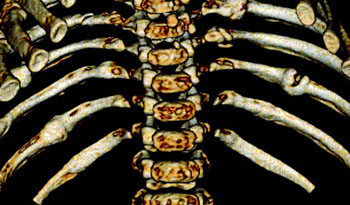CT and MRI Technologies Play Critical Role in Diagnosis of Child Abuse and Neglect
By MedImaging International staff writers
Posted on 07 Jun 2016
Radiologists’ understanding of injuries related to child abuse and neglect has been refined by research and education, and by advances in Computed Tomography (CT) and Magnetic Resonance Imaging (MRI) techniques.Posted on 07 Jun 2016
Since radiologists are often the first witnesses to evidence of physical child abuse or neglect in X-Ray images, a correct interpretation of such cases, and communication of the evidence, may prevent future mistreatment or even save a child’s life.

Image: A 3D reconstruction of a child with multiple rib fractures that could be used by referring healthcare providers in cases of child abuse (Photo courtesy of Sabah Servaes, MD).
In the US alone 1,580 children died from abuse and neglect in 2014, including 70.7% that were younger than three years old. Radiologists are able to find evidence of fractures and other injuries, and differentiate between injuries that result from neglect or physical abuse, or those that are a result of syndromes such as rickets, which can soften and weaken a child’s bones. Child abuse cases in the US often end up in court, and radiologists are sometimes required to testify.
Some medical centers use bone scans with technetium-99 for cases where the suspicion of abuse is high but the skeletal survey of the child is negative. Other centers use whole body Positron Emission Tomography (PET) scans which can detect some child abuse fractures that a skeletal survey cannot, however PET scans are less effective at detecting Classic Metaphyseal Lesions (CML).
Sarah Sarvis Milla, MD, FAAP, Emory University School of Medicine (Atlanta, Georgia), said, “Diagnosing a child abuse case can be a very complex and difficult process. Fortunately, radiologists are not working in a vacuum, but as part of a team of doctors, nurses, social workers and law enforcement officers who want the best outcome for the child.”
Related Links:
Emory University School of Medicine














